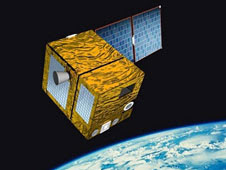After nearly 5 years of concurrent operations with the Afternoon Constellation, known as the "A-Train," the PARASOL satellite is going on another orbit "track." The A-Train includes a number of NASA satellites that orbit the Earth one behind the other on the same track and until this month, PARASOL has been part of that train.

PARASOL is an Earth observation mission, managed by the French Space Agency (CNES). PARASOL stands for "Polarization and Anisotropy of Reflectances for Atmospheric Sciences coupled with Observations from a Lidar." According to CNES, it was maneuvered to leave its position inside the A-Train at 12:48 UTC, December 2, 2009.
The A-Train satellite formation currently consists of five satellites flying in close proximity: Aqua, CloudSat, CALIPSO, PARASOL and Aura. Each of these satellites cross the equator within a few minutes of each another at around 1:30 p.m. local time. By combining the different sets of nearly simultaneous observations, scientists are able to gain a better understanding its main mission, studying the important parameters related to climate change. As an additional benefit, the A-Train satellites provide unique information about tropical cyclones, the collective term for tropical depressions, tropical storms, hurricanes and typhoons.

PARASOL is an Earth observation mission, managed by the French Space Agency (CNES). PARASOL stands for "Polarization and Anisotropy of Reflectances for Atmospheric Sciences coupled with Observations from a Lidar." According to CNES, it was maneuvered to leave its position inside the A-Train at 12:48 UTC, December 2, 2009.
The A-Train satellite formation currently consists of five satellites flying in close proximity: Aqua, CloudSat, CALIPSO, PARASOL and Aura. Each of these satellites cross the equator within a few minutes of each another at around 1:30 p.m. local time. By combining the different sets of nearly simultaneous observations, scientists are able to gain a better understanding its main mission, studying the important parameters related to climate change. As an additional benefit, the A-Train satellites provide unique information about tropical cyclones, the collective term for tropical depressions, tropical storms, hurricanes and typhoons.
No comments:
Post a Comment